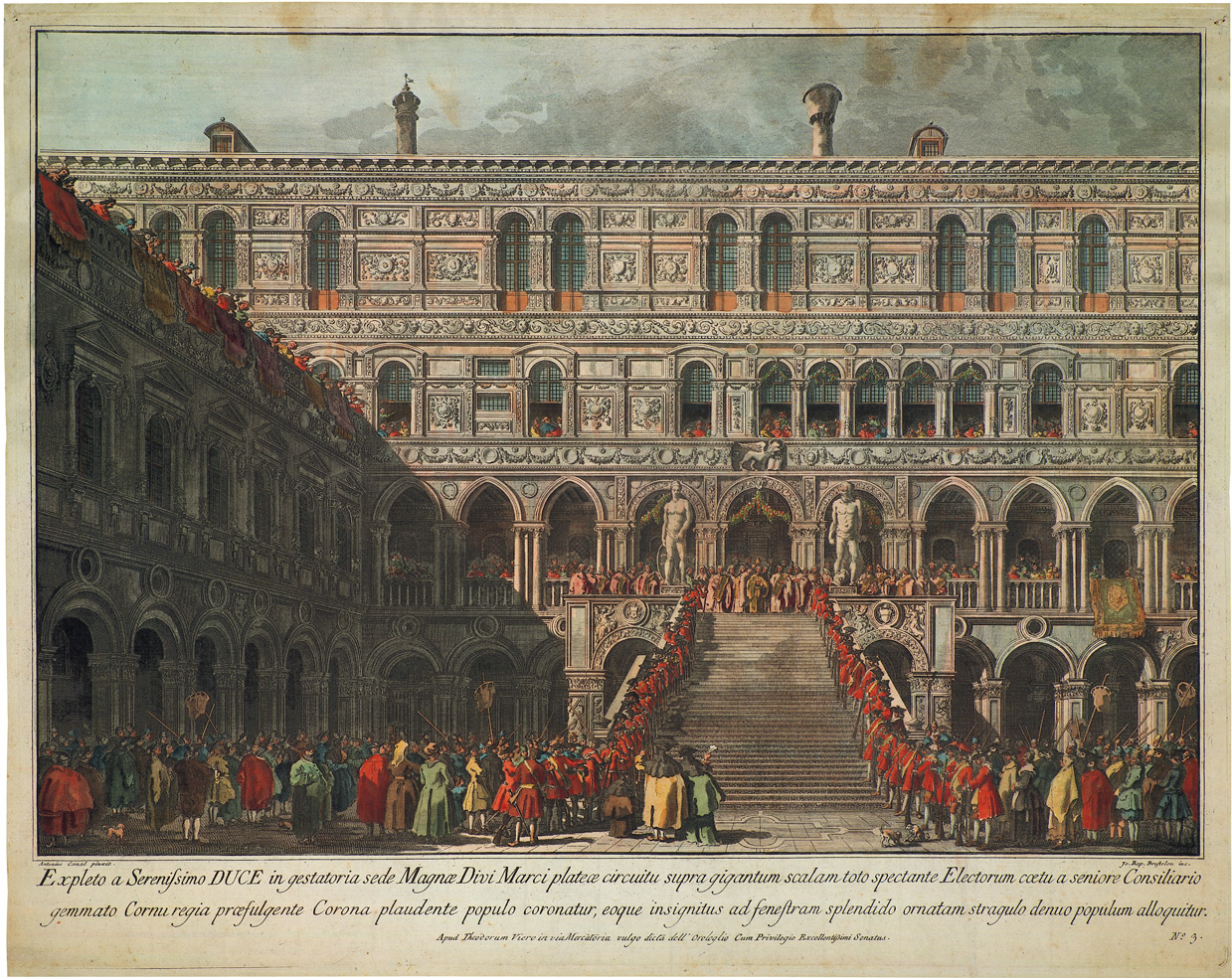Loading the page ...
Giambattista Brustolon
(ca. 1712 Dont di Zoldo – 1796 Venice)
The Coronation of the Doge. Etching and engraving, reworked with watercolour, after a drawing by Antonio Canaletto. 44.5 x 56.7 cm. Le Blanc 6; Pedrocco/Tonini 3 III (of IV). Watermark: Crowned coat of arms with three stars (Bromberg, Canaletto, No. 27; Montecuccoli degli Erri, Canaletto Incisore, No. 9).
In 1766, the reputable Venetian publisher Lodovico Furlanetto commissioned Canaletto to execute a series of drawings illustrating the main festivities of the Serenissima, which were intended to be reproduced in prints. Canaletto had worked on several occasions with Venetian reproductive engravers in the course of his long and illustrious career and, like his patron and agent Consul Joseph Smith, he was fully aware of what the medium of graphic reproduction could do to promote his painting. The artist chosen was Giambattista Brustolon, one of the most respected engravers in Venice at the time, who had learned his trade in the workshop of Guglielmo Zerletti (and evidently not that of Giuseppe Wagner, as previously assumed) and had already worked from Canaletto originals in the past (see F. Montecuccoli degli Erri, “Novità biografi che sull’incisore Giambattista Brustolon, Bellunese”, Ateneo Veneto, 1997, pp. 157–166).
The series com prising of twelve plates and entitled Feste ducali met with quite remarkable success, as is evidenced by the number of editions which continued well into the 19th century. The first publisher, Furlanetto, had already been granted a twenty-year privilege for this project in 1766. The single engravings of the Feste ducali appeared at intervals in the following years. The prints could be bought individually or by subscription for the whole suite. Altogether Furlanetto published two editions of the series, which was completed no later than 1773 or 1774. After the privilege expired in 1786, the plates came into the possession of another business-minded Venetian publisher, Teodoro Viero, who that same year, i.e. during Brustolon’s lifetime, published a third edition. The present print belongs to this third edition and bears in the lower margin the address of Viero, whose publishing house was in the Mercerie not far from the Piazza San Marco. Interestingly enough, as Camillo Tonini notes in a recent publication, copies of the third state are much rarer than impressions of the two preceding ones. The run of the third edition was clearly a small one, a fact which Tonini ascribes to the changes in public taste in the years preceding the fall of the Venetian Republic in 1797 (see Filippo Pedrocco/ Camillo Tonini, Canaletto-Brustolon. Le feste ducali, Venice 2006, p. 11).
Also unusual and rare is the very painstaking and artistically sophisticated colouring of the present print, which distinguishes it from the often crude and schematic colouring of many contemporary popular engravings. It is a little known fact that during the second half of the 18th century the works of important Venetian artists, including Canaletto, were also published as stampe miniate. These hand-coloured impressions were considerably more expensive than black-and-white proofs, and only relatively few copies of these coloured prints, which usually served as wall decorations, have survived (see in this context Federico Montecuccoli degli Erri, Canaletto Incisore, Venice 2002, p. 156–161, fi g. 101–110; see also the invaluable and informative exhibition catalogue by Jan van der Waals, Prenten in de Gouden Eeuw / Van Kunst to Kastpapier, Museum Boijmans van Beuningen, Rotterdam 2006). Viero had obviously hired a very skilled and artistically sensitive colourist in his bottega. The colouring is limited to a few tints – green, reddish brown, sparsely applied yellow and blue – which are nevertheless used in a highly variegated way to maximize the effects of space and atmosphere. The scene depicts the coronation of the Doge on the Scala dei Giganti in the inner courtyard of the Doge’s palace in the presence of the Venetian population, which is depicted in its habitual gusto and verve. The twin ranks of red-uniformed soldiers direct the eye of the beholder to what is actually happening at the top of the great flight of steps. A powerful effect is achieved by the deep shadow which darkens the entire left wing of the inner courtyard and contrasts starkly with the brilliantly sunlit main façade.
An excellent, clear and even impression with narrow margins around the platemark, printed on a firm, contemporary Venetian paper, with perfectly preserved fresh colours. Minor staining, minimal aging, otherwise in excellent condition.
